

PAGE 29
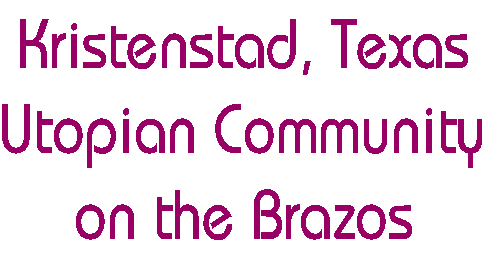
By Jerry Adams
Copyright © 1998, all rights reserved
The tokens:
RAINBOW MARKETING ASSOCIATION, INC. / KRISTENSTAD, / TEXAS
GOOD FOR / 5 / IN MERCHANDISE
Brass-round-21mm
RAINBOW MARKETING ASSOCIATION, INC. / KRISTENSTAD, / TEXAS
GOOD FOR / 10 / IN MERCHANDISE
Aluminum-round-23mm
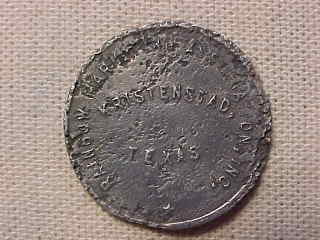
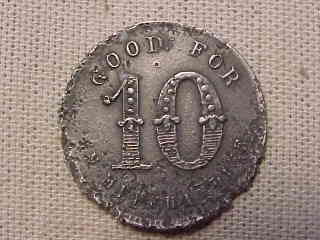
RAINBOW MARKETING ASSOCIATION, INC. / KRISTENSTAD, / TEXAS
GOOD FOR / 25 / IN MERCHANDISE
Brass-round-27mm
RAINBOW MARKETING ASSOCIATION, INC. / KRISTENSTAD, / TEXAS
GOOD FOR / 50 / IN MERCHANDISE
Bimetal-round-31mm
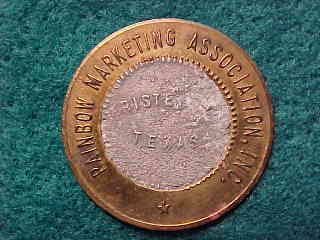
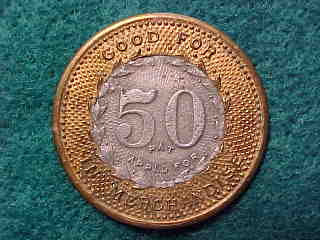
RAINBOW MARKETING ASSOCIATION, INC. / KRISTENSTAD, / TEXAS
GOOD FOR / 1.00 / IN MERCHANDISE
Bimetal-round-38mm
(circa: 1928-1935, estimated value: $15 - $25 each)
John Benjamin Kristensen (or Cristiansen) formed the community of Kristenstad, Texas about 1928 as an experiment in Americanized socialism. Mr. Kristensen’s parents had come to the United States from Denmark, and raised young John B. Kristensen in Kansas City. He was educated at Missouri State University. About 1925, his desire to establish a settlement for Scandinavian farmers led him to establish a settlement for them in eastern Texas. The water in this first settlement was not suitable to sustain the group, and John started looking for another site.
The second site he selected for his group was on the Brazos River, in Somervell County, near Glen Rose. He acquired land there, and moved the group and named the place "Rainbow." The water and land were good, but they did not have enough land for expansion, and thus he set out looking for a more spacious site.
The third and last site selected was in De Cordova Bend of the Brazos River, and was named Kristenstad. The name was possibly taken in honor of Kristenstad, Sweden, or perhaps as a memorial to the towns founder.
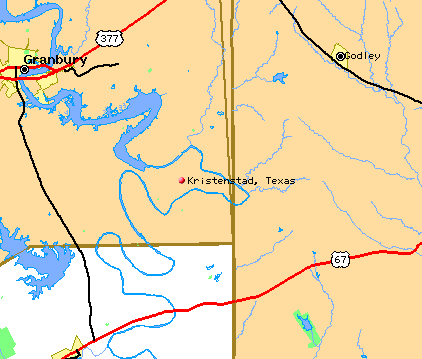
By 1933, the community of Kristenstad, Texas had about 25 families and 146 individuals living in the community. The families were mostly of Scandinavian descent.
The community itself, was a kind of blend of socialism and capitalism, with the land being owned and farmed privately, and the industries of the village being operated on a communal basis during non-farming time. The workers in the industries were paid $2 per day in tokens, which were good at the community operated non-profit store. The community had no public utilities, no piped water, gas or electricity. The communal industries included a cement plant, a chair factory, a charcoal plant, a cheese factory, a wood carving shop, and a monthly magazine called "The Interpreter."
The communal school had 32 students in 1933, and there was also a non-denominational church.
The "Great Depression" of the 1930’s essentially quashed the ability of the outside world to buy the farm and industrial products of Kristenstad. The community post office closed in 1935, and the school closed in 1938. The area was soon deserted as family after family left the area looking for food and work.
The community of Rainbow, Texas still exists, but Kristenstad is no longer there. About all that remains are a few ruins and a cemetery. The tokens of Kristenstad, Texas remind us of a Utopian community that could not survive the economic depression of the 1930’s.
References: "The Token Coinage of Kristenstad, Texas" by Stuart Mosher, April 1933; "The Trade Tokens of Texas" by Fowler, Roberts and Strough, April 1973
On to page 30 of our token web pages...
updated: 5 feb 2000